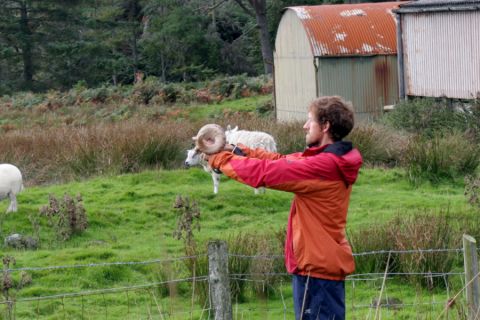So yeah, I started looking into islands. Almost from nowhere I started dreaming about creating a residency on a small island that would examine how islanders relate to their contemporary and historical landscape. I imagined that island communities had a strong sense of identity and connection to their history and culture and I imagined (naively) that most of them would have lived there since the year dot. So I was intrigued to discover the Isle of Eigg in the Scottish Small Isles. An 87 strong population on a 3×5 mile stretch of land with forests, lochs, a plateau, a unique geological rock formation, and a largely immigrant population who had fought and won to own their own island just ten years ago. This recent history defined their identity, and other than two written histories of the island (which is how the tourists see the place) I believed that this is how they defined themselves. But when I began to make contact with islanders and then eventually went on a research trip, it became clear that they we a bit fed up with the disparity between the contemporary history of the buy-out and the complete history of the island. "Yes it was a great achievement, but its been ten years now, perhaps it's time to move on and have something new to celebrate?" I was told in one conversation. Debates were raging about whether or not to encourage a fledgling tourist industry (which is vital for revenue), put up signs (there are almost none), build a museum, encourage immigration and home building. All these elements were creating tensions between the islanders and tourists, and between the islanders themselves, some of which wanted modernization, whilst others wanted to retain their wild idyll.
Archives
Firstly I reckon it is important to explain what it is that I do and why I choose to do it that way:
I call myself an artist, and mainly I work towards relatively large projects with institutions that I find interesting or places where there is an area of unresolved debate around knowledge or history. I go on site visits, arrange meetings with key people and try to secure their interest and participation(which is often the most difficult part of what I do). Then I tie everything together into a proposal for a place and locate funding for it. So as well as artist I am also my own accountant, researcher, funding officer and personal secretary!
It certainly isn't the gallery based route that many of my peers are taking, but I like being in complete control. I also don't have a lot of interest in showing work in a white cube, a place that tries to situate itself out of time and space but which is pretty laden with historical and curatorial baggage. I know dozens of artists who are currently exploring this very thing within their practices.
A friend of mine said "You should be trying to build a mystique", and I suppose that by working like this I am subconsciously trying to do a bit of personal myth-making: "That artist who went round repairing broken road signs, then hid out in museum archives and library catalogues, appeared on a remote Scottish Island recently and did some strange performances…" -kind of thing. Though I am not sure what one does with mystique once obtained?Seems to do wonders for the likes of Marcus Coates, Adam Chodzko, and Matthew Barney though…
Blogs have the interesting quality of being both intensely personal and exposing and yet also being largely overlooked by the majority of the planet who has access to them. This duality has drawn me back to create my second blog for Artists Talking, the first being the project Gaps in Archaeology posted some time last year. I think it is going to be mainly just a fence post to which I can tack the occasional notice of delight or despair about the project that I am currently creating. I think it would be a suitable way of recording the process even if it is only me that goes back to it in the future.
